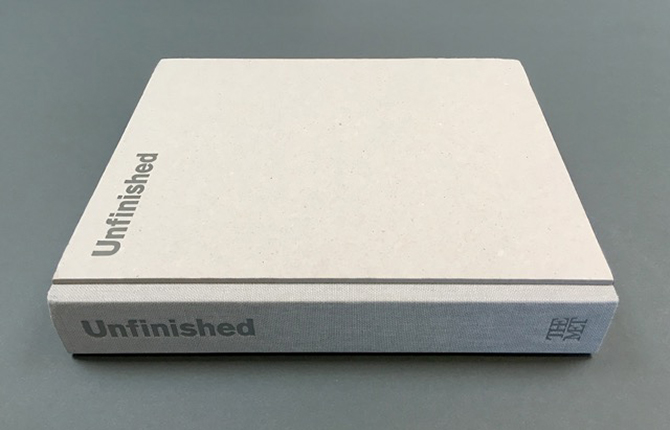
Catalog for inaugural exhibition at The Met Breuer, 2016
1. Pharaoh's Dance
When I was in junior high school, my favorite band was Chicago, the seven-piece horn band famous for "Make Me Smile" and "Saturday in the Park." While my hipper friends found them tame (if not lame), I genuinely liked their music, which I found catchy and inventive. But I suspect that I was just as attracted to the way they were packaged. Columbia Records art director John Berg had commissioned a lush calligraphic logo from Nick Fasciano, and that logo—the same size, the same position—was the only thing that appeared on the band's covers. With one trick. On each new record, Fasciano rendered the logo a different way: built from brushed stainless steel, carved into wood, sewn into a flag, modeled to resemble a candy bar, concealed in a vintage map, one variation after another, each one the same, but somehow different. To a thirteen-year-old who wouldn't have known the word "branding," this was a memorable demonstration of corporate identity in action. I loved Chicago.
I was discussing my enthusiasm with a camp counselor one afternoon in the summer of 1971. He was baffled. "Chicago, they've got trumpets and stuff, right? Like jazz rock?" Yes, I said, I guess you could call it that. "Oh," he said. "Then you should definitely check out Miles Davis. That's what real jazz rock sounds like." That weekend I went to the Parmatown Mall and bought Bitches Brew.
Marc Myers writes a column for the Wall Street Journal called Playlist where he asks people to name the one song that changed their life. Not their favorite song, which is a different question. But the song that fundamentally altered the way they think about the world. A few weeks ago, he put the question to me. I would have had trouble picking a favorite song. But I can pinpoint the moment my mind was changed about what music was and what music could be. It was when I heard the first song, disc one, side one, on Bitches Brew. "Pharaoh's Dance" didn't sound anything like Chicago. It didn't sound like anything. It didn't seem to have any structure, no verses, no bridges. I hated it. But I listened to it again, and then again. I started absorbing its dense, subterranean patterns. And I realized, for the first time but not the last, that something truly new takes time to appreciate and understand.
2. Does This Logo Make Me Look Pathological and Self-Loathing?
We live at a moment that rewards snap judgments, ideally delivered in short Twitter-ready bursts. As a fifty-something graphic designer, for decades I practiced my career in relative obscurity. For most of my life, people have reacted with mild bafflement as I tried to explain what I do for a living. No more. After thirty-five years, suddenly everybody is interested in what I do. I just tell them that I design logos.
Early in 2016, a new logo starting appearing here and there. It was for New York's Metropolitan Museum of Art. Many new logos get criticized for being too simple and boring. The Met's logo is not that. It reduces the name to two red three-letter words—THE MET—and composes those six letters in a complex arrangement, connecting each to the next, merging the verticals in the HE and ME pairs, all in a font with exaggerated serifs that border on flamboyant. It is a nervy, bold design that begs for a strong reaction, and that's what it got.
Justin Davidson from New York fired the first salvo, calling it a "graphic misfire" that looked like "a red double-decker bus that has stopped short, shoving the passengers into each other's backs." Soon, others joined the chorus, including Times critic Michael Kimmelman ("pathological and self-loathing"), Vanity Fair's Paul Goldberger ("the vibe of insecurity"), and Hyperallergic's Jennifer Bostic ("a really unfortunate mistake.")
The visceral reaction provoked by this peculiar combination of letterforms was further augmented by an onslaught of affection for the Met's previous logo. This was a constructed letter M in a circle based on drawings by Franciscan friar Luca Pacioli first published in his book "De divina proportione." People tend to prefer old logos to new ones. The Met M-in-circle had been in use since 1971; if that isn't old enough for you, Pacioli published his book in 1503. Abandoning 500 years of tradition was too much for otherwise progressive designer Karim Rashid, who told the New York Times, "We're talking here about a museum that's all about history. So the best thing they could do is hang on to keeping their mark—or their logo—historic." Of course what Rashid is describing is not a museum, but a cemetery.
3. The More You Know
Okay: I admit it. I liked the new Met logo the first time I saw it, and the more I see it, the more I like it.
There are lots and lots of reasons that this is, if not a great logo, then certainly a better logo than the one it's replacing. The old symbol, that beloved (albeit to my eyes kind of generic and clip-artsy) Pacioli M, needed to be captioned with the full name of the institution: five words, ten syllables, twenty-six letters, all in poor old Trajan. This was cumbersome in every sense, particularly as the institution prepares to open in the former Whitney Museum building on Madison Avenue (to be renamed The Met Breuer after its architect). That new site, along with the less-visited but utterly lovely Cloisters, makes the Met a citywide complex that demands not a monolithic identity, but a way to connect up all the pieces. The new logo, a self-reading wordmark that acknowledges the institution's two-syllable colloquial name, will serve effectively as the hinge for the whole system.
The logo's multiple ligatures are no doubt the new identity's most polarizing element. As an experienced design pitchman, I knew immediately these were meant to signify "connections" well before its designers at Wolff Olins said as much. But more importantly, I'll bet you that I could find half a dozen precedent examples of the same typographic conceit on medieval manuscripts and classical inscriptions within a five-minute walk from the Met's front door. You want history? Here's history. The Met, perhaps the world's most overwhelmingly overstuffed encyclopedic museum, is nothing if not complex. The new logo's refreshingly idiosyncratic typography is a perfect analog for that complexity. And red is the perfect color.
But all of these thoughts came later. The first thing I thought when I saw the new identity was quite simple: If this thing was forty-five years old, it would be the most beloved logo in New York.
4. The Lure of Preemptive Cleverness
All the fuss that's made about logos camouflage an embarrassing secret: people are reluctant to admit how they actually work.
Imagine it's 1968, and you're the head of marketing for a midwestern department store called Target. You go to the country's most respected corporate identity consultants, Unimark International, and they give you a cleaned-up logo that's … well, a target: a red dot with a red circle around it. Blessedly, social media hasn't been invented yet, so you're spared the now-inevitable Twitterstorm ("How much did they pay for this?" and "This is the best they could come up with?" and the mandatory "My five-year-old … " etc.). Nonetheless, there must have been some doubtful whispers in the corporate hallways.
What you couldn't have told anyone—what you couldn't have even guessed—was what would happen over the next five decades: that the blank simplicity of the mark would enable an astonishing range of creative uses. There are many examples of symbols that might have been dismissed as underwhelming at their birth, from Chanel to Nike. What they have in common is what Paul Rand called "the pleasure of recognition and the promise of meaning." What everyone gets confused about is the difference between meaning and the promise of it; like the "pursuit of happiness," what you're guaranteed is not success but its potential.
How do you design for potential meaning? How do you convince a client to view a new identity not as a purchase, but as an investment?
I have been increasingly fascinated by this process in recent years. When my team was working on a new logo for a major telecommunications company last year, I felt we had arrived at a solution that solved every problem but one: it didn't demonstrate how creative we were. After many attempts, I came to feel that all these gestures were self-indulgent and, in fact, interfered with the communication of clarity and simplicity. We went with the simple solution and took the consequences.
Along the course of my career I became addicted to something I've come to think of as preemptive cleverness, delivering logo systems that appear to be fully articulated on day one. Like moving into a fully furnished house, this can be reassuring and convenient. But at the same time, it makes it much harder to make the place your own. Something more open ended allows, and even invites, participation. I remain haunted by a great example, those Nick Fasciano's logos for Chicago I loved when I was thirteen: one design, endlessly inventive variations. They may even have led me to wonder if a presidential campaign could use the same strategy.
5. Just Wait
Most design disciplines think in the long term. Architects design buildings to last for generations; industrial designers create products that will withstand endless hours, if not years, of use.
Graphic designers, whether we admit it or not, are trained for the short term. Most of the things we design have to discharge their function immediately, whether it's a design for a book or a poster, a website or an infographic, a sign system, or a business card. In school critiques, architecture and industrial design students produce models. Graphic designers produce finished prototypes. As a result, the idea that we create things that are unfinished, that can only accrue value over time, is foreign to us. It's so easy for us to visualize the future, and so hard to admit that we really can't. That's what we face every time we unveil a new logo.
And so every time a major identity is introduced today, it's subjected to immediate scrutiny. Why not? It's fun. It's risk free. Every client wants to have an audience "connect on an emotional level with their brand." And then when they do, it's not always what they hoped for. People love the Metropolitan Museum of Art. Naturally they take it personally when the Met decides to change its logo.
Whether we want to acknowledge it or not, anyone evaluating a brand new logo at first glance is — to paraphrase my partner Paula Scher — reviewing a three-act play based on what they see the moment the curtain goes up. Or, to put it differently, they think they're judging a diving competition when in fact they're judging a swimming competition. The question isn't what kind of splash you make. It's how long you can keep your head above water.


Comments [10]
03.01.16
09:53
03.01.16
11:09
03.01.16
11:49
03.01.16
12:00
03.01.16
07:10
03.02.16
02:06
03.02.16
09:28
03.02.16
05:24
03.02.16
08:36
03.08.16
04:21